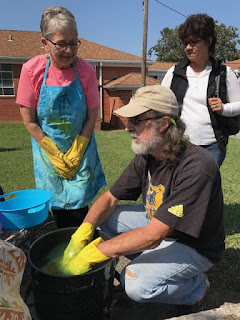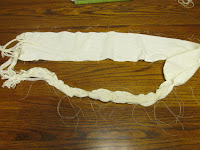For
the third year I was at the Smoky Mountain Fiber Arts Festival in
Townsend, TN. I have on other years been demonstrating spinning in the
days prior to the festival then demonstrating weaving and/or spinning at
the actual festival. This year they weren't at the Visitor Center in
the days prior to the festival, but I went up early to help set up the
Heritage Center ready for the arrival of the vendors on Thursday -
little did I know, but more on that later.
The
Townsend Artisan Guild is a prime organizer of the festival with support
from the Tennessee Valley Handspinners Guild. I am a member of both
guilds so can't help but be involved.
As in previous
years we set up the tent at a campground across the road from the
Heritage Center. It's very convenient and a simple walk across the road
once everything is set up. There are plenty of places to eat and we
tend to sample local BBQ and Mexican and then always make the most of
there being a great coffee shop located just down the road. The folk at
the Artistic Bean know us well now - and my standard large latte is
typically underway before I get to the counter each morning.


Our
tent is a fairly large tent and we normally get a site that has power
on so that we can recharge phones and use the fan in the muggy heat
typical of the Smoky Mountains at this time of year. Pitching the tent
is now pretty fast - I've done it often enough. With both of us it
takes barely 10 minutes, and not a lot longer with just me. Taking it
down again and packing it away takes about the same time. This year the
weather forecast was for a lot more rain than previous years and on the
day I traveled up I managed to arrive in a break in the light rain and
was able to get the tent up and everything unpacked before the main rain
came that night. As we have discovered previously we have a couple of
seams on the sides that leak a little, but otherwise everything stays
dry - more on that later too.



I decided to use the TAG loom again this year - it's a Harrisonville
Design 22" portable jack loom. The warp on it had been there for at
least two years and was nearly at the end so I had prepared a cotton
warp at home and planned to dress the loom in the couple of nights
before the festival began. There is plenty of room in the center of the
tent and winding on went pretty well - only broke one thread when I
took my eye off the lease sticks for a second. I dressed back to front
and certainly missed my two big looms where I can remove the breast beam
and sit down low right in front of the reed and heddles to thread the
warp.
I
finished all that on Tursday morning and once it was all tied on I was
able to weave a small sample before folding up the loom ready to be
delivered to the Heritage Center the following day.
I
was in my normal spot on the porch in front of the Transportation
Station where they had a few of the many vendors. There was also a wet
felting demonstration by Bridgett, set up next to me - the idea was that
we would draw customers from the front entry into the first of the
vendor spaces - I guess that worked as we had a steady stream from
opening at 9 am through to the close at 5.
Anne
arrived in Townsend having driven directly from work on Friday
afternoon. She was able to bring a temple that I had forgotten which
proved useful the following day. Both Friday and Saturday I had a lot
of interesting conversations and managed to answer a few questions and
pass on some tips - the most appreciated was how to 'soften' new linen -
a process I read somewhere and which as worked very well on our linen
place mats.
On Friday night after dinner and after
sitting around the firepit with some of the Scenic Vally Handweavers
members the heavens decided to open up and along with thunder and
lightning we retreated to our tent for the evening to watch some Netflix
episodes. Unfortunately the noise of the rain on the tent pretty well
killed that idea! It was late enough so we climbed into bed only to
discover an hour or so later that we had a small lake in the tent that
had come about by leaving a small gap unzipped at the bottom of the back
door. It must have poured in there and been soaked up by the large rag
rug we have until such time as it reached saturation and then flowed
down to the lower side of the tent. Our bed and in it us stayed dry but
our clothes and other bits and pieces were soaked. We headed for the
laundry and managed to pop everything in dryers to dry - and as the rain
had stopped continued watching some Netflix.
The
following day (Saturday) was fine all day, but the weather forecast was
for thunderstorms and rain from late in the day and all through Sunday.
With the prospect of packing ourselves and the tent in the rain we
decided to pack up and head home once I finished at the festival that
afternoon. Best decision we ever made as Anne was able to pack the car
and prepare the tent and when I arrived back at the camp ground we
packed the dry tent etc into the truck and headed away. Heading south
we drove through parts of the storm that would have hit us an hour or so
later in Townsend - it would have been terrible. Safely home we were
able to unpack a little and settle down as the rain started here.
Before
leaving Townsend I ended up volunteering taking on the job of vendor
coordinator for the festival next year to give the current guild member a
break. Our first meeting will be in the next couple of weeks. I'll
time that with a trip up there to visit the shop/gallery.

















































